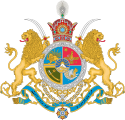Hosein Pir-Nia

Hosein Pir-Nia (persiska: حسین پیرنیا) , även känd som Mo'tamen al Molk, född 1875 i Teheran, Iran, död 1948 i Teheran, var en iransk ämbetsman och politiker under qajarerna och Reza Pahlavi.
Karriär
Han var talman för landets parlament från 1914 till 1925 och igen från 1928 till 1929.
Pirnia spelade en betydande roll i utarbetandet av Persiens konstitution från 1906 och fungerade som utbildningsminister 1918 och minister utan portfölj 1920. Han valdes till varje session i parlamentet (majles) från 1906, och fungerade som talare under mer än elva år.[1] 1943 invaldes han från Teheran till det fjortonde parlamentet men avböjde att tjänstgöra.
Hosein Pir-Nias far, Mirza Nasrollah Khan, och hans äldre bror, Hasan Pir-Nia, var båda Irans premiärminister.
Hosein Pir-Nia var svärfar till generalen och politikern Fazlollah Zahedi och farfar till politikern Ardeshir Zahedi.
Referenser
- ^ Cyrus Ghani, Iran and the Rise of Reza Shah: From Qajar Collapse to Pahlavi Power, London, 2000.
Media som används på denna webbplats
حسین پیرنیا؛ ششمین رئیس مجلس شورای ملی
Imperial Coat of Arms of Iran under the Pahlavi Dynasty, used from 1925 to 1979. The shield is composed of the Lion and the Sun symbol in first quarter , in the second quarter the Faravahar representing Zoroastrianism, in the third quarter the curved blade of a Imam Ali "Zulfiqar" sword representing Shia Islam, and the Simurgh in the fourth quarter. Overall in the center is a circle depicting Mount Damavand with a rising sun, the symbol of the Pahlavi dynasty. The shield is crowned by the Pahlavi crown and surrounded by the chain of the Order of Pahlavi. Two lions rampant regardant, holding scimitars supports the coat of arms on either side. Under the whole device is the motto: "Mara dad farmud va Khod Davar Ast" ("Justice He bids me do, as He will judge me" or, alternatively, "He gave me power to command, and He is the judge"). Some of the colours were changed in 1971.


